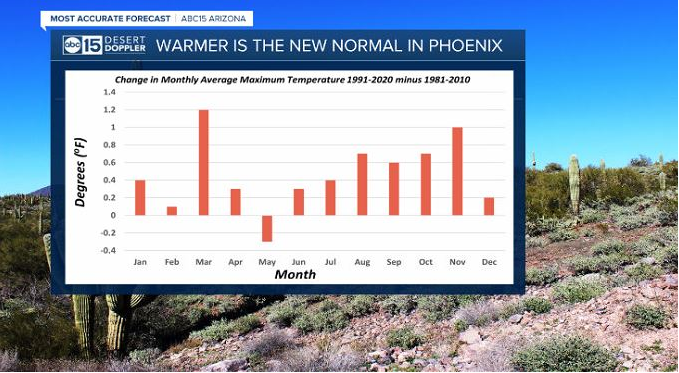PHOENIX — The city of Phoenix is investigating a new technology that could soon fight climate change in cities across the world.
Warmer is the new normal in Phoenix.
The monthly average temperature in the city has been on the rise for the past few decades — both in the daytime and at night.
Researchers already know that a combination of climate change and urban development leads to a rise in overnight low temperatures in Phoenix.
Along with reducing greenhouse gases, mitigating the urban heat island could help slow the trend of rising temperatures, and there is research happening in the Phoenix area to test new technologies that could make a difference in how to cool cities in the future.


That's the idea behind a stretch of roadway in the Garfield District, south of downtown Phoenix.
It is one of eight neighborhoods in the Phoenix area where an asphalt sealant product called CoolSeal by manufacturer GuardTop is being tested as a method to mitigate the heat island effect.
Jennifer Vanos is an assistant professor at Arizona State University. She says the goal of the CoolSeal is to reflect the sun's energy back into space, so that the heat is not absorbed by the asphalt as would typically happen with traditional sealants.
"No city has tried this before the way Phoenix is trying this and so we're really leading in that space globally," Vanos said.
The research is looking at the benefits and potential effects of CoolSeal. So far, research has found that the surface temperature of the asphalt coated by the CoolSeal is 16 degrees lower than the asphalt covered by traditional sealcoats.
The air temperature above asphalt covered by SealCool is also colder by about 0.44 degrees.
"Now that doesn't sound like a lot, and it's not necessarily something our body would be able to feel," Vanos said. "But one of the goals we have over the coming year is to be able to take those numbers for each neighborhood and do calculations on what that means for energy use, and what that means for water use, and what that does potentially mean for human health."
David Sailor is the Director of Urban Climate Research at Arizona State. He says the CoolSeal can help reduce how much of the sun's energy is absorbed, but new technology could further cool the surrounding air.
Sailor says "passive radiative cooling material" reflects and radiates energy, so the surface is cooler than the air temperature at all times.
"It's a game-changer of sorts in the ability to cool our cities because even a white surface on a rooftop...those white surfaces still remain a little bit hotter than the air temperature during the day, so you're adding heat to the environment, not as much as a dark surface but they are adding heat," Sailor said. "If we replace that white surface with a passive radiative cooling surface, it would actually be below air temperature at all times, and that would allow us to further cool the environment."
The new technology could also allow for heat island mitigation strategies to be implemented on a wider scale, even in homes. In addition, the materials come in darker colors, so it would mean that homeowners could benefit from the cooling effects without necessarily having to have a white or light-colored roof.
While not all of these technologies are on the market yet, Sailor says now is the time to start considering them as part of the future of infrastructure.
"We have our fate in our own hands," Sailor said. "Let's take advantage of that, and the more that we can make our cities livable, thriving communities, the better we sort of guard against the risk of flight away from our cities."
While the new technologies could make a difference in how cities fight heat islands, Sailor says it's important to always look at any adverse consequences. That way, policymakers can make informed decisions as cities continue to grow and develop.
This story was originally published by Iris Hermosillo on Scripps station KNXV in Phoenix.




